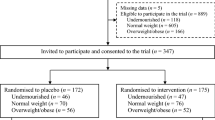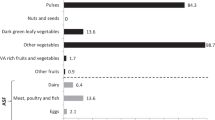Abstract
Background/Objectives:
A multiple micronutrient-fortified drink could be an effective strategy to combating micronutrient deficiencies in school going children. To assess the efficacy of a multiple micronutrient-fortified drink in reducing iron deficiency (ID), ID anemia (IDA), anemia and improving micronutrient status among schoolchildren with low iron stores. The study employed a school-based, randomized, double-blind, placebo-controlled design.
Subjects/Methods:
Schoolchildren with low serum ferritin (SF <20 μg/l) (n=246), aged 6–12 years were randomly assigned to receive either a multi-micronutrient fortified or an unfortified identical control drink. The drinks were provided 6 days/week for 8 weeks. Anthropometric and biochemical assessments were taken at baseline and endline.
Results:
Study groups at baseline were comparable, and compliance to the intervention was similar. The overall prevalence of ID, IDA and anemia was 64%, 19% and 24%, respectively. The prevalence of ID, IDA, vitamin C and vitamin B12 deficiencies significantly reduced by 42%, 18%, 21% and 5%, respectively, in the intervention arm (P<0.01) as compared with the control arm at the end of the study. Similarly, the concentration of hemoglobin, SF, vitamin A, vitamin B12, vitamin C and body iron stores were significantly higher in the intervention arm in comparison to the control arm (P<0.001). Red cell folate levels also improved significantly in the intervention arm (P=0.04), however, serum zinc status did not change in either of the study arms. Children who had received the fortified drink had significantly lower odds of being ID (0.15; 95% confidence interval (CI): 0.09–0.27), IDA (0.14; 95% CI: 0.04–0.52), vitamin B12 deficient (0.36; 95% CI: 0.18–0.73) and vitamin C deficient (0.24; 95% CI: 0.13–0.46), after adjusting for baseline age, gender and weight.
Conclusions:
The multi micronutrient-fortified drink was efficacious in reducing the prevalence of ID, IDA, vitamin C and vitamin B12 deficiency and improved micronutrient status in schoolchildren.
This is a preview of subscription content, access via your institution
Access options
Subscribe to this journal
Receive 12 print issues and online access
$259.00 per year
only $21.58 per issue
Buy this article
- Purchase on Springer Link
- Instant access to full article PDF
Prices may be subject to local taxes which are calculated during checkout

Similar content being viewed by others
References
Diaz JR, de las Cagigas A, Rodriguez R . Micronutrient deficiencies in developing and affluent countries. Eur J Clin Nutr 2003; 57 (Suppl 1), S70–S72.
Sivakumar B, Nair KM, Sreeramulu D, Suryanarayana P, Ravinder P, Shatrugna V et al. Effect of micronutrient supplement on health and nutritional status of schoolchildren: biochemical status. Nutrition 2006; 22 (Suppl 1), S15–S25.
Ranum P . Solving micronutrient deficiency problems. Cereal Foods World 2001; 46: 441–443.
Beaton GH . Iron needs during pregnancy: do we need to rethink our targets? Am J Clin Nutr 2000; 72 (Suppl 1), 265S–271S.
Allen LH, Peerson JM, Olney. DK . Provision of multiple rather than two or fewer micronutrients more effectively improves growth and other outcomes in micronutrient-deficient children and adults. J Nutr 2009; 139: 1022–1030.
Ash Deborah M, Tatala SR, Frangillo EA, Ndossi GD, Latham MC . Randomized efficacy trial of a micronutrient-fortified beverage in primary school children in Tanzania. Am J Clin Nutr 2003; 77: 891–898.
Abrams SA, Mushi A, Hilmers DC, Griffin IJ, Davila P, Allen L . A multinutrient-fortified beverage enhances the nutritional status of children in Botswana. J Nutr 2003; 133: 1834–1840.
Solon FS, Sarol JN, Bernardo AB, Solon JA, Mehansho H, Sanchez-Fermin LE et al. Effect of a multiple-micronutrient-fortified fruit powder beverage on the nutrition status, physical fitness, and cognitive performance of schoolchildren in the Philippines. Food Nutr Bull 2003; 24 (Suppl 4), S129–S140.
Cook JD, Flowers CH, Skikne. BS . The quantitative assessment of body iron. Blood 2003; 101: 3359–3364.
Harrison GG, Buskirk ER, Lindsay Carter JE, Johnston FE, Lohman TG, Pollock ML et al. Skinfold thicknesses and measurement technique. In: Lohman TG, Roche AF, Martorell R,, (eds). Anthropometric Standardization Reference Manual., Champaign, IL: Human Kinetics, 1988 55–70.
de Onis M, Onyango AW, Borghi E, Siyam A, Nishida C, Siekmann J . Development of a WHO growth reference for school-aged children and adolescents. Bull World Health Organ 2007; 85: 660–667.
Nga TT, Winichagoon P, Dijkhuizen MA, Khan NC, Wasantwisut E, Furr H et al. Multi-micronutrient-fortified biscuits decreased prevalence of anemia and improved micronutrient status and effectiveness of deworming in rural Vietnamese school children. J Nutr 2009; 139: 1013–1021.
van Stuijvenberg ME, Kvalsvig JD, Faber M, Kruger M, Kenoyer DG, Benade AJ . Effect of iron-, iodine-, and beta-carotene-fortified biscuits on the micronutrient status of primary school children: a randomized controlled trial. Am J Clin Nutr 1999; 69: 497–503.
Winichagoon P, McKenzie JE, Chavasit V, Pongcharoen T, Gowachirapant S, Boonpraderm A et al. A multimicronutrient-fortified seasoning powder enhances the hemoglobin, zinc, and iodine status of primary school children in North East Thailand: a randomized controlled trial of efficacy. J Nutr 2006; 136: 1617–1623.
Hallberg L, Brune M, Erlandsson M, Sandberg AS, Rossander-Hulten L . Calcium: effect of different amounts on nonheme- and heme-iron absorption in humans. Am J Clin Nutr 1991; 53: 112–119.
Thankachan P, Walczyk T, Muthayya S, Kurpad AV, Hurrell RF . Iron absorption in young Indian women: the interaction of iron status with the influence of tea and ascorbic acid. Am J Clin Nutr 2008; 87: 881–886.
Walczyk T, Davidsson L, Zavaleta N, Hurrell RF . Stable isotope labels as a tool to determine the iron absorption by Peruvian school children from a breakfast meal. Fresenius J Anal Chem 1997; 359: 445–449.
Hurrell RF Iron Fortification of Foods. Academic Press: Orlando, FL, 1985.
Villalpando S, Shamah T, Rivera JA, Lara Y, Monterrubio E . Fortifying milk with ferrous gluconate and zinc oxide in a public nutrition program reduced the prevalence of anemia in toddlers. J Nutr 2006; 136: 2633–2637.
Zimmermann MB, Biebinger R, Rohner F, Dib A, Zeder C, Hurrell RF et al. Vitamin A supplementation in children with poor vitamin A and iron status increases erythropoietin and hemoglobin concentrations without changing total body iron. Am J Clin Nutr 2006; 84: 580–586.
Semba RD, Bloem. MW . The anemia of vitamin A deficiency: epidemiology and pathogenesis. Eur J Clin Nutr 2002; 56: 271–281.
Combs GF The Vitamins: Fundamental Aspects in Nutrition and Health. Elsevier: San Diego, 2008.
Antony AC . Megoblastic anemias. In: Hoffman R, Benz EJ, Shattil SS, et al. (eds). Hematology: Basic Principles and Practice. 5th edn., Elsevier Churchill Livingstone; Philadelphia, PA,, 2008 Chapter 39.
ICMR. Nutrient Requirements and Recommended Dietary Allowances for Indians. A Report of the Expert Group of the Indian Council of Medical Research. National Institute of Nutrition: Hyderabad, 2009.
Zimmermann MB, Biebinger R, Rohner F, Dib A, Zeder C, Hurrell RF et al. Vitamin A supplementation in children with poor vitamin A and iron status increases erythropoietin and hemoglobin concentrations without changing total body iron. Am J Clin Nutr 2006; 84: 580–586.
Evans T . Regulation of hematopoiesis by retinoid signaling. Exp Hematol 2005; 33: 1055–1061.
Sirivech S, Frieden E, Osaki S . The release of iron from horse spleen ferritin by reduced flavins. Biochem J 1974; 143: 311–315.
Powers HJ, Bates CJ, Prentice AM, Lamb WH, Jepson M, Bowman H . The relative effectiveness of iron and iron with riboflavin in correcting a microcytic anaemia in men and children in rural Gambia. Hum Nutr Clin Nutr 1983; 37: 413–425.
Decker K, Dotis B, Glatzle D, Hinselmann M . Riboflavin status and anaemia in pregnant women. Nutr Metab 1977; 21 (Suppl 1), 17–19.
Samson D, Halliday D, Chanarin I . Reversal of ineffective erythropoiesis in pernicious anaemia following vitamin B12 therapy. Br J Haematol 1977; 35: 217–224.
Smith CLM, Marks DB, Marks AD Marks’ essential medical biochemistry. Lippincott Williams & Wilkins: Hagerstwon, MD, 2007.
Kumar MV, Rajagopalan S . Multiple micronutrient fortification of salt and its effect on cognition in Chennai school children. Asia Pac J Clin Nutr 2007; 16: 505–511.
Manger MS, Mckenzie JE, Winichagoon P, Gray A, Chavasit V, Pongcharoen T et al. A micronutrient-fortified seasoning powder reduces morbidity and improves short-term cognitive function, but has no effect on anthropometric measures in primary school children in northeast Thailand: a randomized controlled trial. Am J Clin Nutr 2008; 87: 1715–1722.
Osendarp SJ, Baghurst KI, Bryan J, Calvaresi E, Hughes D, Hussaini M et al. Effect of a 12-mo micronutrient intervention on learning and memory in well-nourished and marginally nourished school-aged children: 2 parallel, randomized, placebo-controlled studies in Australia and Indonesia. Am J Clin Nutr 2007; 86: 1082–1093.
Sumithra Muthayya A, Eilander C, Transler T, Thomas HCM, van der Knaap KS et al. Effect of fortification with multiple micronutrients and n-3 fatty acids on growth and cognitive performance in Indian schoolchildren: the CHAMPION (Children's Health and Mental Performance Influenced by Optimal Nutrition) Study. Am J Clin Nutr 2009; 89: 1766–1775.
Acknowledgements
We are most grateful to the principals and teachers of the schools, the children and their parents for their participation in the study. We want to express our thanks to all our colleagues who were involved in data collection, biochemical analyses and the preparation and distribution of drinks: Stella Mary, Beena Bose, Kiran and all the study staff from St John’s Medical College and Research Institute, Bangalore. This study was supported by Coca-Cola, India.
Author information
Authors and Affiliations
Corresponding author
Ethics declarations
Competing interests
AVK is a member of the Kraft Health and Wellness Advisory Board. The remaining authors declare no conflict of interest.
Rights and permissions
About this article
Cite this article
Thankachan, P., Selvam, S., Surendran, D. et al. Efficacy of a multi micronutrient-fortified drink in improving iron and micronutrient status among schoolchildren with low iron stores in India: a randomised, double-masked placebo-controlled trial. Eur J Clin Nutr 67, 36–41 (2013). https://doi.org/10.1038/ejcn.2012.188
Received:
Revised:
Accepted:
Published:
Issue Date:
DOI: https://doi.org/10.1038/ejcn.2012.188
Keywords
This article is cited by
-
Effectiveness of a fortified drink in improving B vitamin biomarkers in older adults: a controlled intervention trial
Nutrition & Metabolism (2021)
-
Prevalence of Vitamin B12 and Folate Deficiency in School Children Residing at High Altitude Regions in India
The Indian Journal of Pediatrics (2017)
-
Back-transformation of treatment differences—an approximate method
European Journal of Clinical Nutrition (2014)



